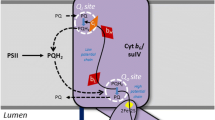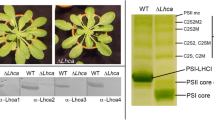Abstract
State transitions and lateral migration of phosphorylated ‘mobile’-LHC II upon thylakoid unstacking have been reported as being interdependent. However, now the thyakoid unstacking event can be separated from the thyakoid phosphorylation and the associated F730/F685 enhancement by using the serine-type-protease inhibitor benzamidine. Thus, lateral migration appears not be necessary, and it can be shown that LHC II-rich fragments, originating in peripheral granal membranes, can be released by digitonin although in reduced amounts. On the other hand, phosphorylation of thylakoid proteins greatly stimulates the light-induced D1 degradation, which is observed in chloroplasts phosphorylated even at very low light (15 µmol m−2s−1). Thylakoid pretreatment with FSBA (the PS II protein-kinase inhibitor) blocks the light-induced and ATP-stimulated D1 degradation, and the F730/F685 ratio increase; this suggests that the dissociation of the PS II unit, resulting from the introduction of repulsive negative charges ( ATP groups) into LHC II and PS II core proteins, leads to D1 degradation. In chloroplast samples transferred to darkness following short-time phosphorylation, the D1 level is recovered. The results suggest that disassembly of PS II and D1 degradation occur parallel to State transitions. The removal of outer phospho-LHC II from PS II and its association with PS I at the periphery of grana may allow D1 degradation and increased light utilization by PS I, while net de novo synthesis of D1, stimulated by ATP, may lead to the assembly of new PS II units which could bind dephosphorylated LHC II in the dark, resulting in increased light utilization by PS II.
Similar content being viewed by others
References
Albertsson P-A (1995) The structure and function of the chloroplast photosynthetic membrane-a model for the domain organization. Photosynth Res 46: 141-149
Allen JF (1992) Protein phosphorylation in regulation of Photosynthesis. Biochim Biophys Acta 1098: 275-335
Allen JF, Bennett J, Steinback KE and Arntzen CJ (1981) Chloroplast protein phosphorylation couples plastoquinone redox state to distribution of excitation energy between photosystems. Nature 291: 21-25
Anastassiou R and Argyroudi-Akoyunoglou JH (1995) Thylakoid-bound proteolytic activity against LHC II apoprotein in bean. Photosynth Res 43: 241-250
Anderson JM and Boardman NK (1966) Fractionation of the photochemical systems of photosynthesis. Chlorophyll content and photochemical activities of particles isolated from spinach chloroplasts. Biochim Biophys Acta 112: 403-421
Andree S, Spittel M and Weis E (1995) Distribution, organization and functional state of PS I, PS II and LHC-complexes in thylakoids after LHC II phosphorylation. In: Mathis P (ed) Photosynthesis: From Light to Biosphere, Vol III, pp 233-236. Kluwer Academic Publishers, Dordrecht, the Netherlands
Argyroudi-Akoyunoglou JH (1976) Effect of cations on the reconstitution of heavy subchloroplast fractions (grana) in disorganized low-salt agranal chloroplasts. Arch Biochem Biophys 176: 267-274
Argyroudi-Akoyunoglou JH and Akoyunoglou G (1986) Is lateral movement of pigment-protein complexes required for grana unstacking? In: Akoyunoglou G and Senger H (eds) Regulation of Chloroplast Differentiation, pp 329-338. AR Liss, New York
Aro E-M, Virgin I and Andersson B (1993) Photoinhibition of Photosystem II. Inactivation, protein damage and turnover. Biochim Biophys Acta 1143: 113-134
Barbato R, Friso G, Rigoni F, Frizzo A and Giacometti GM (1992) Characterization of a 41 kDa photoinhibition adduct in isolated photosystem II reaction centers. FEBS Lett 309: 165-169.
Barber J (1980) An explanation for the relationship between salt-induced thylakoid stacking and the Chl afluorescence changes associated with changes in spillover of energy from PS II to PS I. FEBS Lett 118: 1-10
Bennett J (1991) Protein phosphorylation in green plant chloroplasts. Annu Rev Plant Physiol 42: 282-311
Bennett J, Steinback K and Arntzen CJ (1980) Chloroplast phosphoproteins: Regulation of excitation energy transfer by phosphorylation of thylakoid membrane polypeptides. Proc Natl Acad Sci USA 77: 5253-5257
Biggins J, Campbell CL and Bruce D (1984) Mechanism of the light state transitions in photosynthesis. Biochim Biophys Acta 767: 138-144
Blake MS, Johnston KH, Russell GJ and Gotschlich EC (1984) A rapid sensitive method for detection of alkaline phosphatase-conjugated anti-antibody on Western blots. Anal Biochem 136: 175-179
Cheng L and Allen JF (1995) ATP-dependent effects on redox regulation of chloroplast protein synthesis. In: Mathis P (ed) Photosynthesis: From Light to Biosphere, Vol III pp 579-582. Kluwer Academic Publishers, Dordrecht, the Netherlands
Davies KJA (1987) Protein damage and degradation by oxygen radicals. J Biol Chem 262: 9895-9901
Ellis RJ (1981) Chloroplast proteins: synthesis, transport and assembly. Annu Rev Plant Physiol 32: 111-137
Farchaus J, Dilley RA and Cramer WA (1985) Selective inhibition of the spinach thylakoid LHC II protein kinase. Biochim Biophys Acta 809: 17-26
Georgakopoulos JH and Argyroudi-Akoyunoglou JH (1994a) Release of a ‘light’ thylakoid membrane fragment with high F730/F685 fluorescence emission ratio (77 K) by digitonin disruption from ‘low-salt'-destacked or phosphorylated thylakoids of pea. J Photochem Photobiol 26: 57-65
Georgakopoulos JH and Argyroudi-Akoyunoglou JH (1994b) On the question of lateral migration of LHC II upon thylakoid protein phosphorylation in isolated pea chloroplasts: The stroma lamellar fraction separated from phosphorylated chloroplasts is not homogeneous. Biochim Biophys Acta 1188: 380-390
Giardi M (1993) Phosphorylation and disassembly of the Photosystem II core as an early stage of photoinhibition. Planta 190: 107-113
Hoffman-Falk H, Mattoo AK, Marder JB and Edelman M (1982) General occurrence and structural similarity of the rapidly synthesized, 32,000-dalton protein of the chloroplast membrane. J Biol Chem 257: 4583-4587
Horton P and Lee P (1984) Phosphorylation of chloroplast thylakoids decreases the maximum capacity of Photosystem-II electron transfer. Biochim Biophys Acta 767: 563-567
Horton P, Allen JF, Black MT and Bennett J (1981) Regulation of phosphorylation of chloroplast membrane polypeptides by the redox state of plastoquinone. FEBS Lett 125: 193-196
Kyle DJ, Haworth P and Arntzen CJ (1982) Thylakoid membrane protein phosphorylation leads to a decrease in connectivity between Photosystem II reaction centers. Biochim Biophys Acta 680: 336-342
Kyle DJ, Ohad I and Arntzen CJ (1984a) Membrane protein damage and repair: selective loss of quinone-protein function in chloroplast membranes. Proc Natl Acad Sci USA 81: 4070-4074
Kyle DJ, Kuang TY, Watson JL and Arntzen CJ (1984b) Movement of a sub-population of the light-harvesting complex (LHC II) from grana to stroma lamellae as a consequence of its phosphorylation. Biochim Biophys Acta 765: 89-96
Kuhn M and Boeger P (1990) Studies on the light-induced loss of the D1 protein in Photosystem II membrane fragments. Photosynth Res 23: 291-296
Laemmli UK (1970) Cleavage of structural proteins during assembly of the head of bacteriophage T4. Nature 277: 680-685
Mackinney G (1941) Absorption of light by chlorophyll solutions. J Biol Chem 140: 315-322
Mattoo AK and Edelman M (1987) Intramembrane translocation and posttranslational palmitoylation of the chloroplast 32-kDa herbicide-binding protein. Proc Natl Acad Sci USA 84: 1497-1501
Mattoo AK, Hoffman-Falk H, Marder J and Edelman M (1984) Regulation of protein metabolism: coupling of photosynthetic electron transport to in vivodegradation of the rapidly metabolized 32 kDa protein of the chloroplast membranes. Proc Natl Acad Sci USA 81: 1380-1384
Mishra NM and Ghanotakis DF (1994) Exposure of a Photosystem II complex to chemically generated singlet oxygen results in D1 fragments similar to the ones observed during aerobic photoinhibition. Biochim Biophys Acta 1187: 296-300
Miyao M, Ikeuchi M, Yamamoto N and Ono T-a (1995) Specific degradation of the D1 protein of Photosystem II by treatment with hydrogen peroxide in darkness: Implication for the mechanism of degradation of the D1 protein under illumination. Biochemistry 34: 10019-10026
Murata N (1969) Control of excitation transfer in Photosynthesis. Biochim Biophys Acta 189: 171-181
Okada K, Satoh K and Katoh S (1991) Chloramphenicol is an inhibitor of photosynthesis. FEBS Lett 295: 155-158
Okada K, Ikeuchi M, Yamamoto N, Ono T-a and Miyao M (1996) Selective and specific cleavage of the D1 and D2 proteins of Photosystem II by eposure to singlet oxygen: Factors responsible for the susceptibility to cleavage of the proteins. Biochim Biophys Acta 1274: 73-79
Rintamaki E, Kettunen R and Aro E-M (1996) Differential D1 dephosphorylation in functional and photodamaged Photosystem II centers. Dephosphorylation is a prerequisite for degradation of damaged D1*. J Biol Chem 271: 14870-14875
Sane PV, Goodchild DJ and Park RB (1970) Characterization of chloroplast Photosystem 1 and 2 separated by a non-detergent method. Biochim Biophys Acta 216: 162-178
Satoh K (1992) Organization of the Photosystem II reaction center. In: Argyroudi-Akoyunoglou JH (ed) Regulation of Chloroplast Biogenesis, pp 375-382. Plenum Press, New York
Steinback KE, Bose S and Kyle DJ (1982) Phosphorylation of the light-harvesting Chlorophyll-protein regulates excitation energy distribution between Photosystem II and Photosystem I. Arch Biochem Biophys 216: 356-361
Telfer A, Hodges M, Millner PA. and Barber J (1984) The cation-dependence of the degree of protein phosphorylation-induced unstacking of pea thylakoids. Biochim Biophys Acta 766: 554-562
Telfer A, Marder J B and Barber J (1987) Photosystem II reaction centers isolated from phosphorylated pea thylakoids carry phosphate on the D1 and D2 polypeptide subunits. Biochim Biophys Acta 893: 557-563
Towbin H, Staehelin T and Gordon J (1979) Electrophoretic transfer of proteins from polyacrylamide gels to nitrocellulose sheets: procedure and some applications. Proc Natl Acad Sci USA 76: 4350-4354
Tziveleka L-A and Argyroudi-Akoyunoglou J H (1995) Cations control the association of a stroma protease to thylakoids. Involvement of the proteolytic activity in ‘low-salt'-induced grana unstacking and pigment-protein complex organization? In: Mathis P (ed) Photosynthesis: From Light to Biosphere, Vol III, pp 835-838. Kluwer, Dordrecht, the Netherlands
Author information
Authors and Affiliations
Rights and permissions
About this article
Cite this article
Georgakopoulos, J.H., Argyroudi-Akoyunoglou, J.H. Implication of D1 degradation in phosphorylation-induced state transitions. Photosynthesis Research 53, 185–195 (1997). https://doi.org/10.1023/A:1005819826279
Issue Date:
DOI: https://doi.org/10.1023/A:1005819826279




